Every FIFA World Cup cycle, some players deliver standout performances on the biggest possible stage, illuminating their names in lights and ensuring they become a hot topic in the transfer rumour mill.
Angers’ 22-year-old central midfielder Azzedine Ounahi (182cm/6’0”, 72kg/158lbs) is one of the prime prospects to have emerged from Qatar with a soaring reputation going into the 2023 January transfer window. The Morocco star, who moved from Championnat National 1 side US Avranches to Ligue 1 Angers in the summer of 2021, saw his Transfermarkt valuation skyrocket from €3.5m to €15m off the back of his World Cup, as an indication of the effect that the tournament had on his reputation.
Subsequently, we’ve seen the player linked with a move away from Ligue 1’s bottom-placed side, with the likes of Serie A’s Napoli and Leicester City and Tottenham Hotspur of the EPL touted as potential buyers.
At the time of writing, Ounahi remains an Angers player but for how long that will last remains to be seen, and it’d be wise of Le SCO to have plans for replacing Ounahi in case an offer that’s too good to turn down comes in for the 22-year-old or if the club believes now is the perfect time to cash in on the midfielder for a hefty profit.
This tactical analysis will focus on how Angers may replace Ounahi. We’ll offer some insight into a player from Ligue 2’s Caen who we’ve identified as a potential fit for the ‘Ounahi role’ in this Angers side: 22-year-old Bilal Brahimi (177cm/5’10”, 70kg/154lbs).
This name will sound familiar to Angers fans, as Le SCO signed another now-22-year-old named Billal Brahimi (two ‘l’s in the first name) the summer they acquired Ounahi. This Brahimi, a winger, was subsequently sold for a hefty profit to Ligue 1 rivals Nice just a few months later in the 2022 January transfer window, where he continues playing his football today.
The Bilal Brahimi we’ll discuss in this scout report is the same age as Billal Brahimi and Ounahi, but primarily plays as a central midfielder, similar to Ounahi, not his namesake.
Brahimi has performed well in Ligue 2 in his minutes, but he hasn’t played every minute of every game thus far by any means and while we feel he’s thrived with his minutes thus far, a jump to Ligue 1 this January may be risky.
This is not to mention Brahimi also only joined Caen this past summer from USL Dunkerque, which could make a January move more difficult for Angers to pull off, though as Nice showed when they signed Billal Brahimi from Angers last January, it can happen.
Still, we feel this player could be an excellent option for Angers to consider, even if he’d take more time to bed into the side than Angers can realistically afford if he’s to help them out of the relegation zone this season, with Le SCO currently seven points from safety. His future should lie in Ligue 1 and Brahimi may be an immensely valuable asset for Angers to invest some of the money from their hypothetical Ounahi sale into even if they are ultimately relegated from the top flight this term.
This piece will provide some analysis of Ounahi’s role within Angers’ strategy and tactics, as well as Brahimi’s role within seventh-placed Ligue 2 side Caen’s strategy and tactics. We’ll compare the two players stylistically and in terms of what exactly they offer to explain why we feel Brahimi is a player Angers must monitor as a potential transfer target.
Data comparison
We’ll kick off this tactical analysis by looking at both players’ respective percentile ranks in key areas (split by ‘attacking’, ‘possession’ and ‘defending’) displayed on individual pizza charts from the 2022/23 campaign to provide a data comparison of the two midfielders.
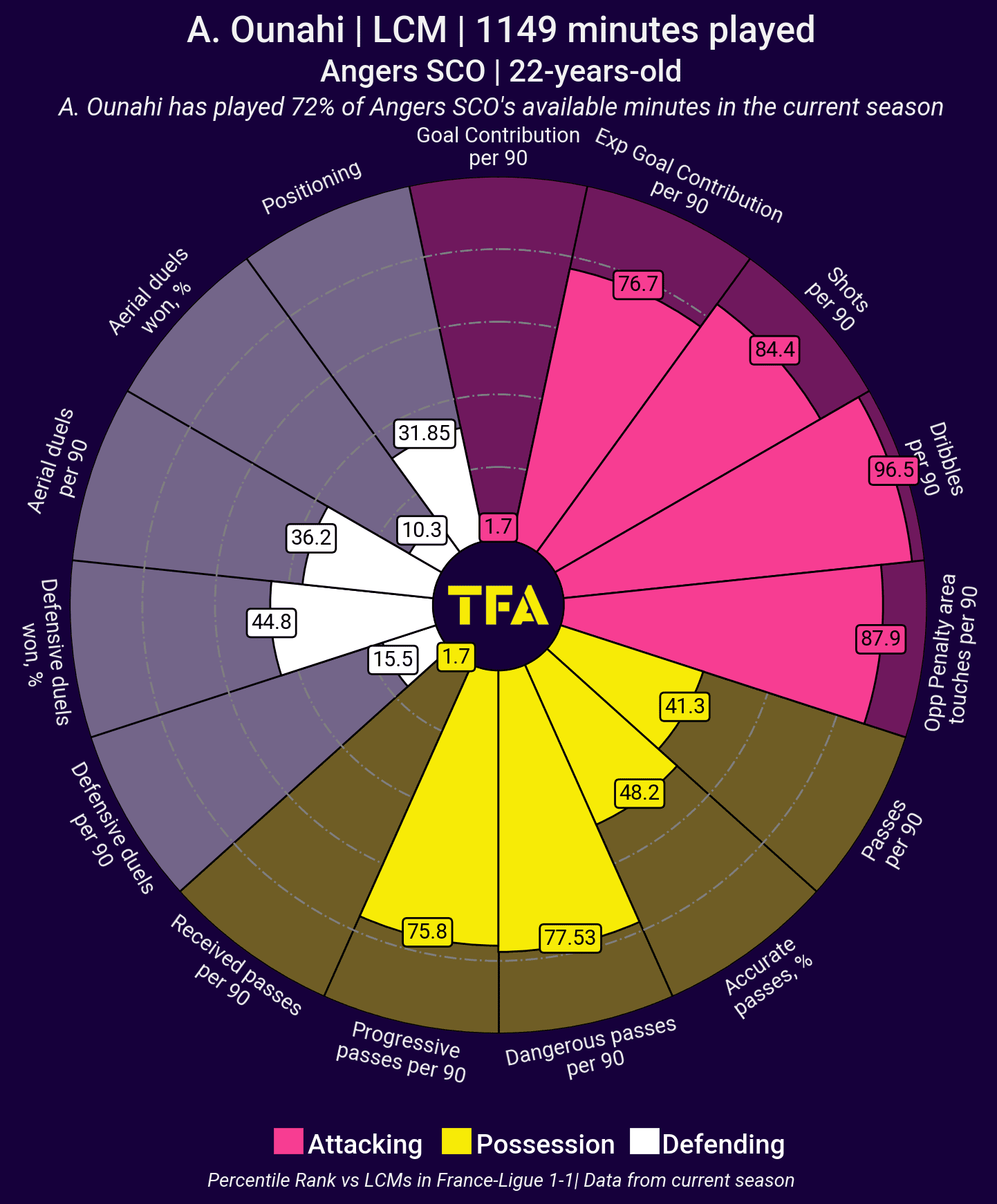
Starting with Ounahi in figure 1, we can see that when compared with other Ligue 1 players in his position from 2022/23, he ranks very highly in key attacking metrics, including expected goal contributions per 90, shots per 90, dribbles per 90 and opposition penalty area touches per 90; along with some key passing metrics — progressive passes per 90 and dangerous passes per 90.
Defensively, while he wins a fair amount of his duels, it’s obvious that he doesn’t offer a tonne in this area and the slack needs to be picked up by his midfield partners in return for what he can offer the team on the ball.
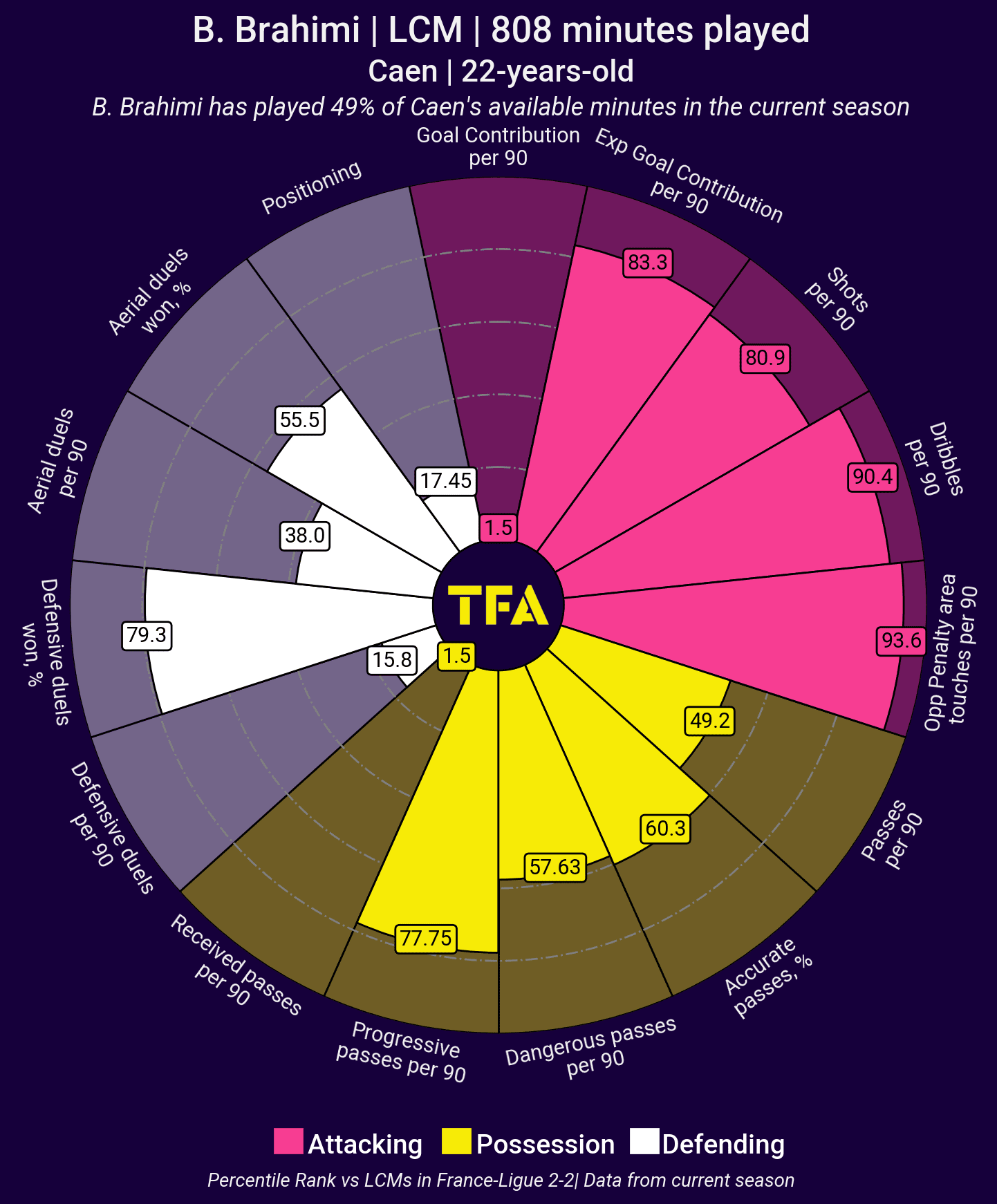
As for Brahimi, then, take a look at figure 2. Primarily a left central midfielder like Ounahi, Brahimi’s pizza chart is not too dissimilar at all to the Angers man’s in figure 1. He stands out in the same four key attacking metrics that Ounahi stood out in — and to a similar degree. While Brahimi’s pass accuracy trumps Ounahi’s and he makes fewer dangerous passes than Ounahi, the Caen midfielder also stands out in progressive passes per 90.
Defensively, Brahimi’s percentile ranks are nothing to write home about either, though his duel success is far more promising than Ounahi’s. Obviously, Brahimi’s competing at a lower level than Ounahi, which is so important to bear in mind when looking at this data and comparing the two players. With that in mind, stylistically, the two players have a resemblance.
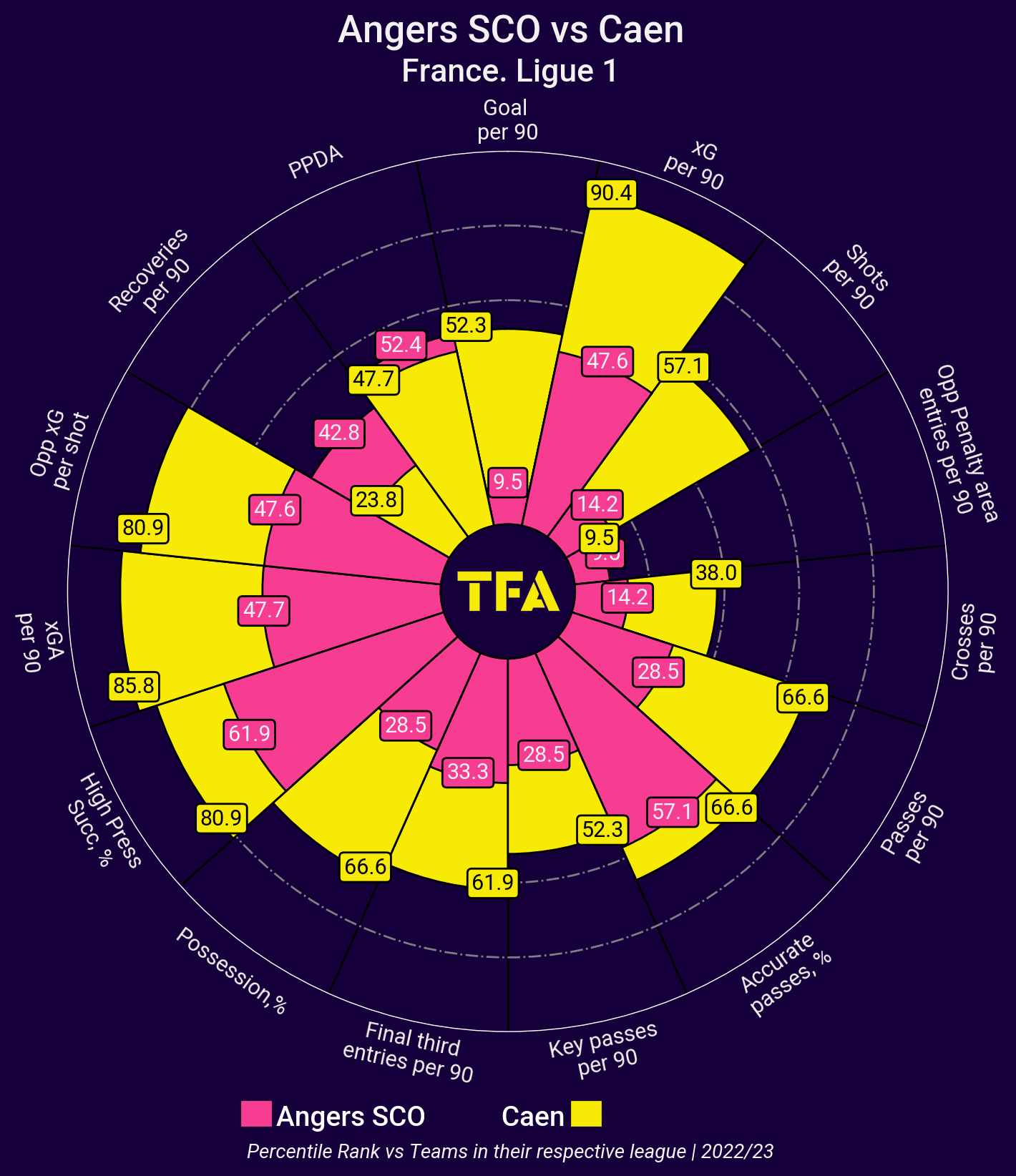
The stylistic comparisons don’t carry over to the two players’ respective teams. Caen are stronger in Ligue 2 than Angers are in Ligue 1; as a result, they score more goals, generate more xG and typically keep more of the ball, for instance — with stronger teams generally dominating the ball more than weaker teams. This context is important to keep in mind too when comparing the two players and their respective performances this season.
Both teams have a similar percentile ranking for PPDA, but Angers’ PPDA is higher at 13.08 to Caen’s 10.7. Caen will typically press a small bit more aggressively in a given game than Angers will but Brahimi has a similar low level of defensive engagement to Ounahi. However, there is a bit more energy to Brahimi’s pressing than Ounahi’s, with Ounahi often being slow to react to turnovers and offer help in transition to defence.
Passing comparison
Ounahi is an important progressive passer and playmaker from central midfield for Angers. He makes plenty of passes into the final third and frequently breaks the opposition’s defensive lines with his passing from the edge of the final third, helping his team to invade this critical zone.
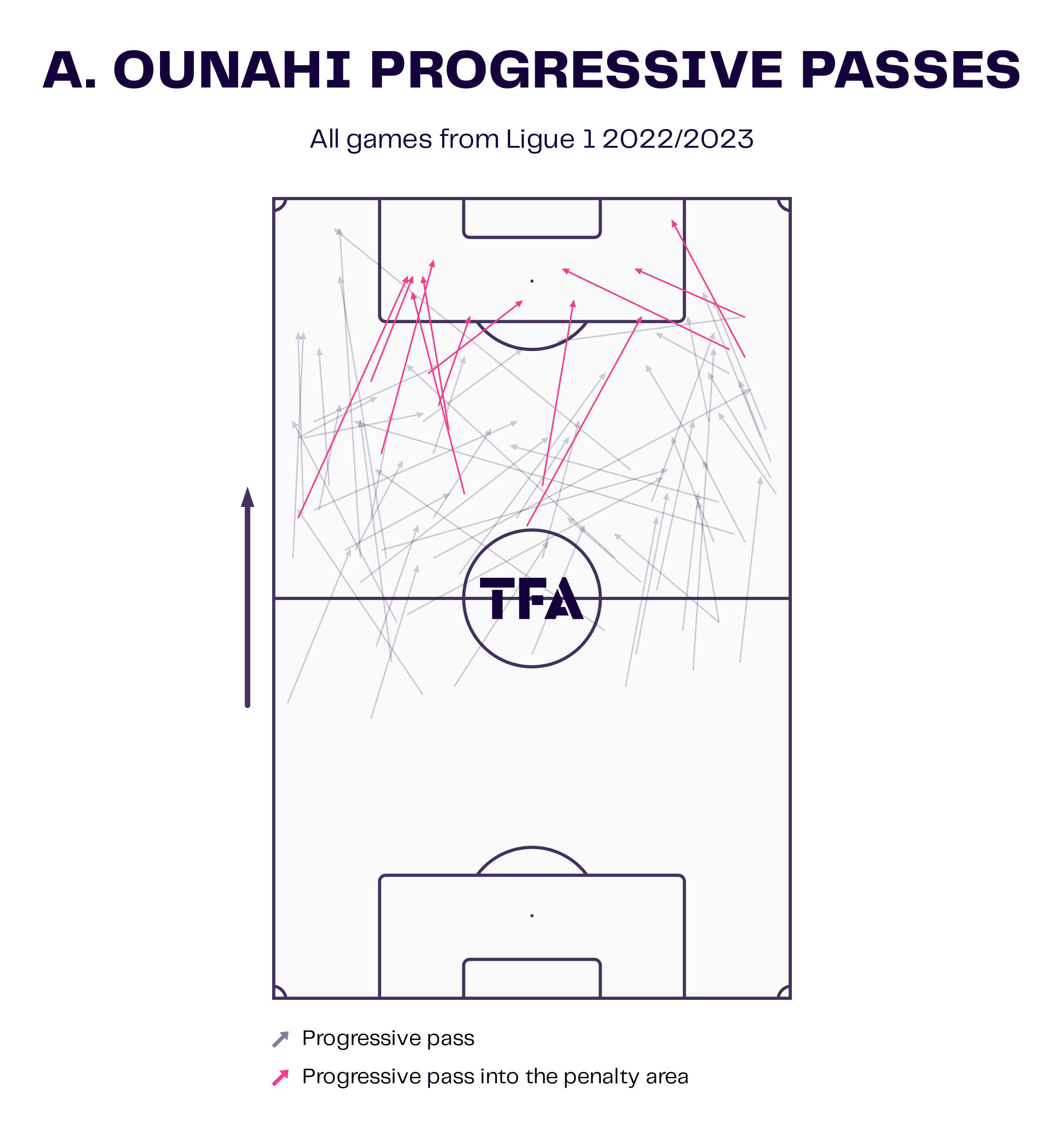
Figure 4 displays Ounahi’s progressive passes (highlighting progressive passes into the penalty area) from 2022/23, further highlighting his tendency to drive his team into the final third from just outside of that particular area in this visual. He regularly plays these balls from the half-spaces but is happy to pass from more centrally as well if the space is available. He’ll more commonly find opportunities to get his head up and make these passes in the half-spaces and as a left central midfielder — most commonly from the left half-space.
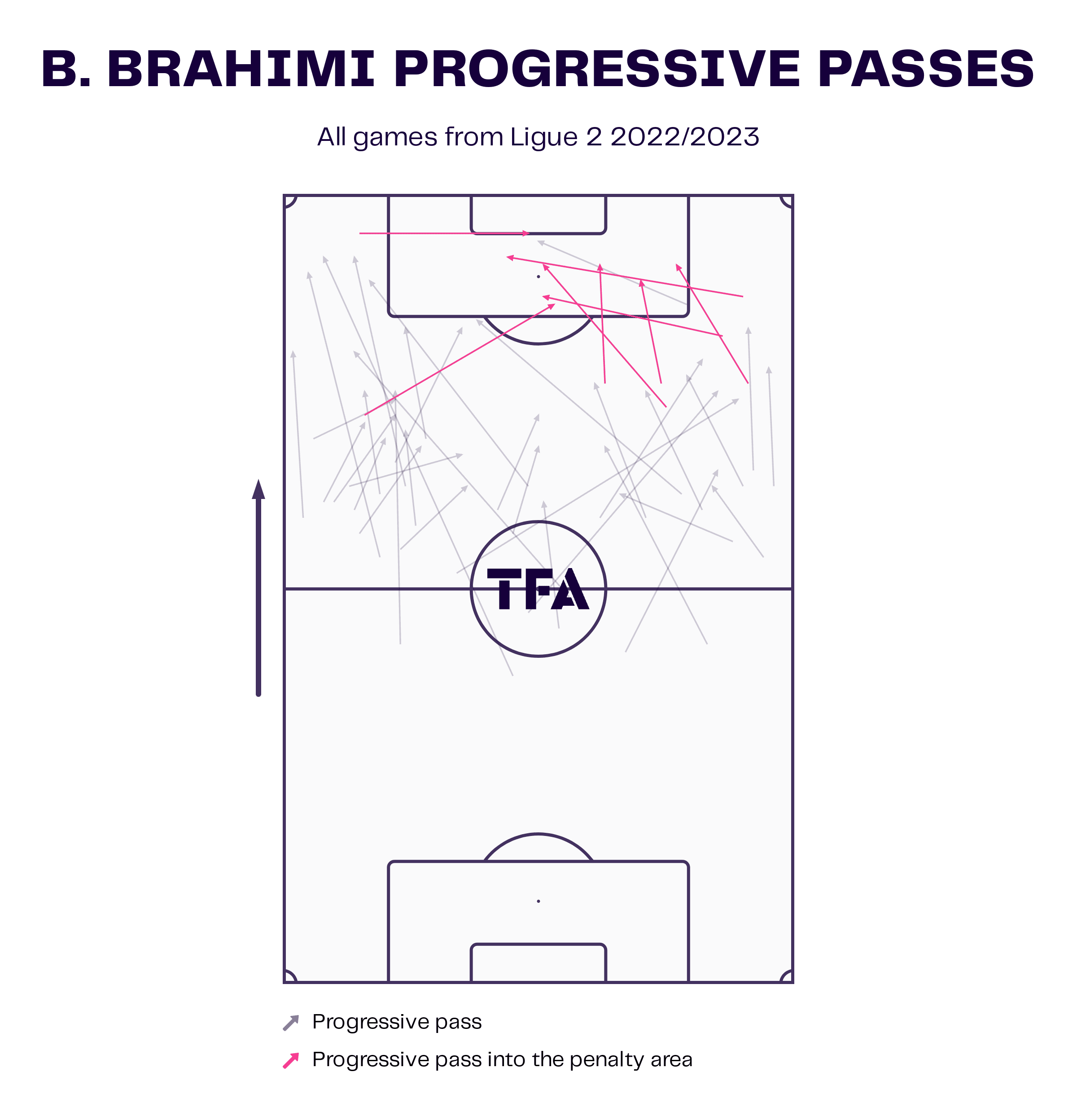
Brahimi has a similar role at Caen, but generally covers shorter distances with his progressive passes and hasn’t progressed his team into the penalty area or directly set up goalscoring opportunities with these passes as much as Ounahi this season.
With the passes that Brahimi has played into the penalty area, most are shorter balls whereas, for Ounahi, these balls tended to cover a significant distance more often than not.
Again, though, we see lots of progressive passing from the half-spaces here — especially the left half-space where we find Brahimi a lot of the time due to his role within the Caen setup.
Like Ounahi, Brahimi plays a decent number of passes into the final third; the Caen man is, perhaps, more careful with these passes, retaining a higher success rate with them, while Ounahi, at present, is quicker to get the ball forward and is more of a risk-taker in that regard.
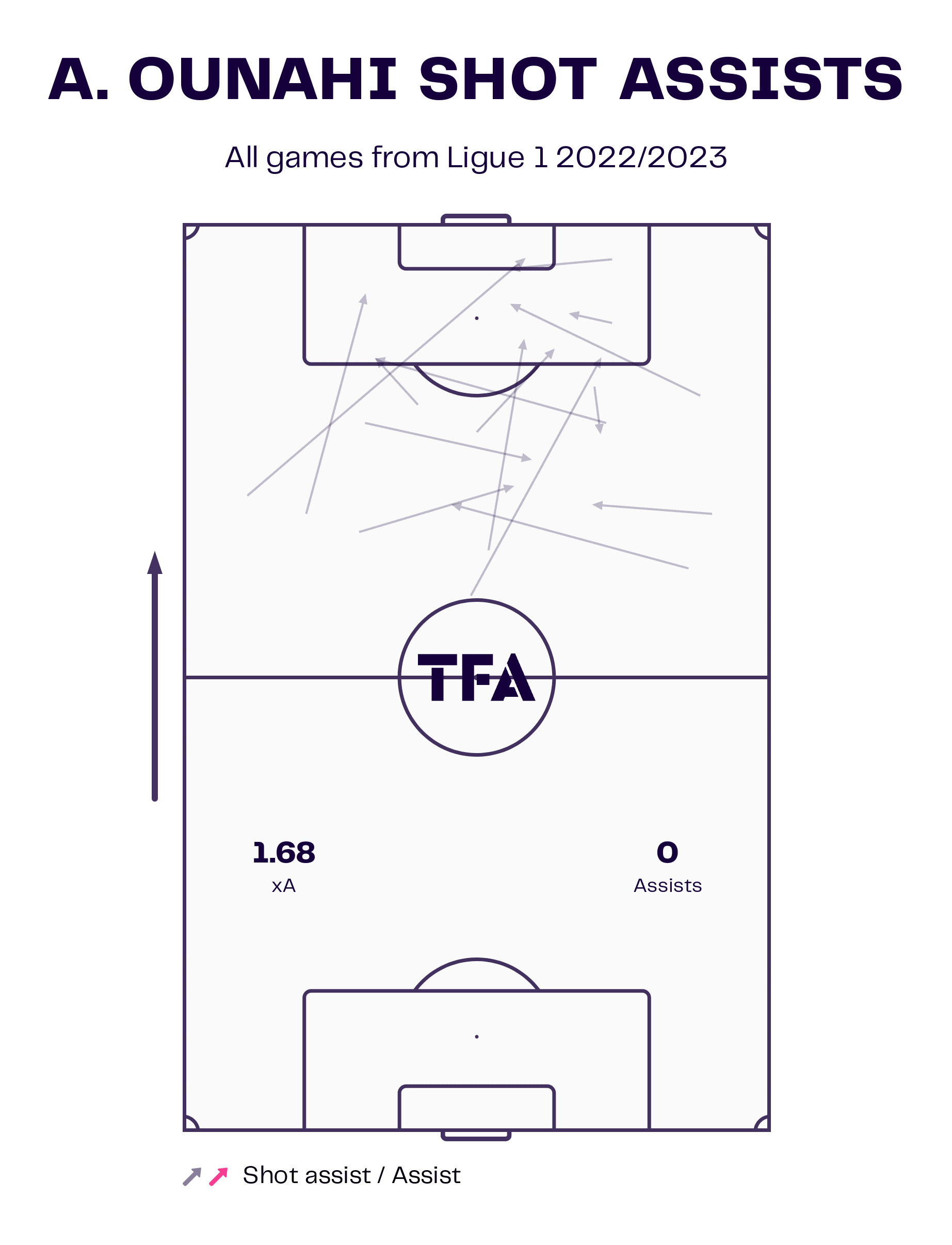
In figure 6, we see Ounahi’s shot assists from the 2022/23 campaign. The passes are scattered around quite a bit, perhaps a result of Ounahi’s freedom to exploit space quite a bit in possession and carry the ball into dangerous positions for Angers, but we can see how some of his progressive, line-splitting passes into the final third directly resulted in shots for his team.
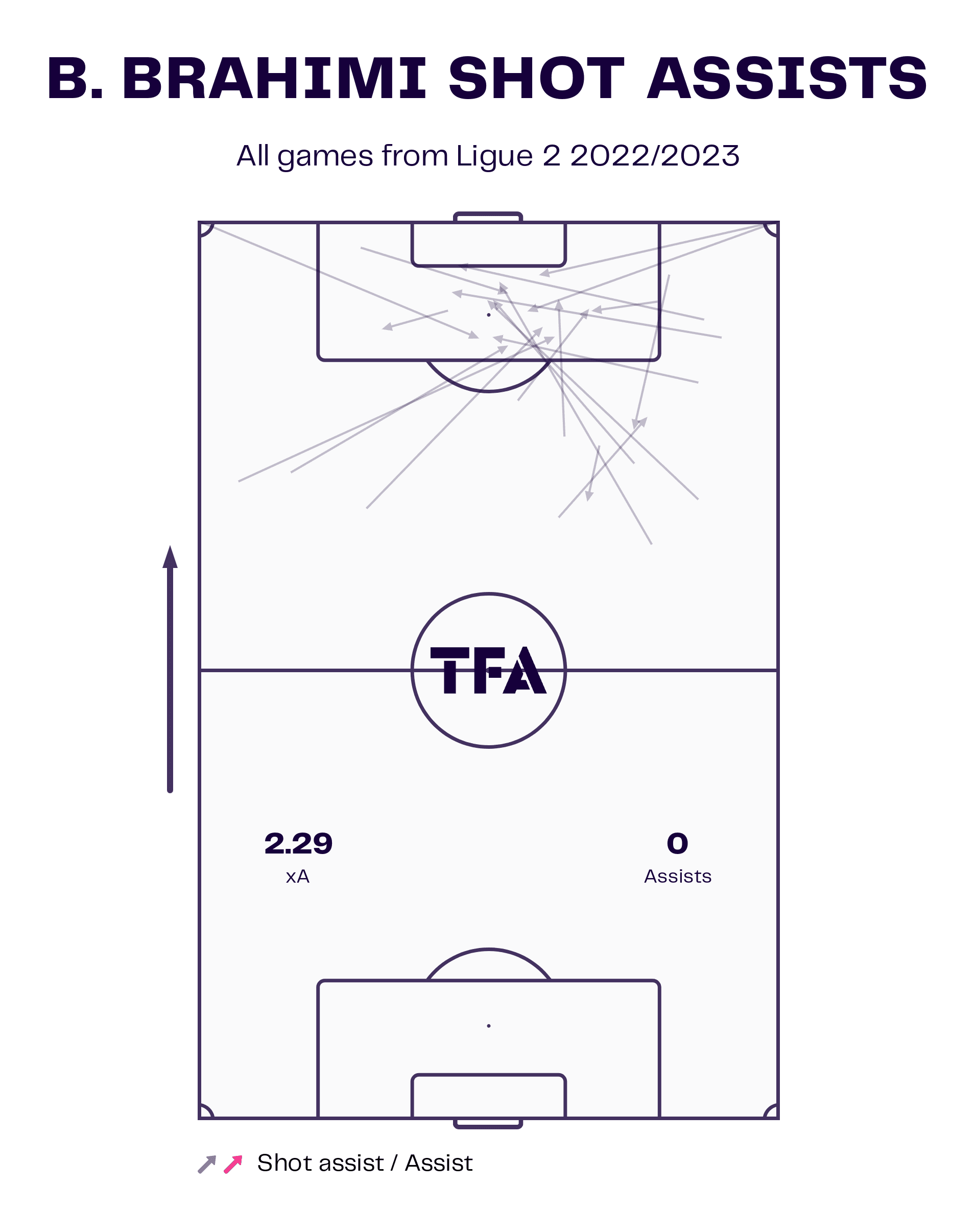
As for Brahimi, we have a lot more to go off of in this regard, as he’s generated a higher xA than Ounahi this season (Brahimi has generated a highly impressive 0.25 xA per 90 this season — the second-highest among central midfielders/attacking midfielders with at least 300 minutes in Ligue 2) and we have a more noticeable trend of his passes from the half-spaces into the penalty area directly resulting in shots at goal. These are the exact positions Angers like to find Ounahi in and Brahimi has proven his ability to create heavily from these areas in Ligue 2 so far this term.
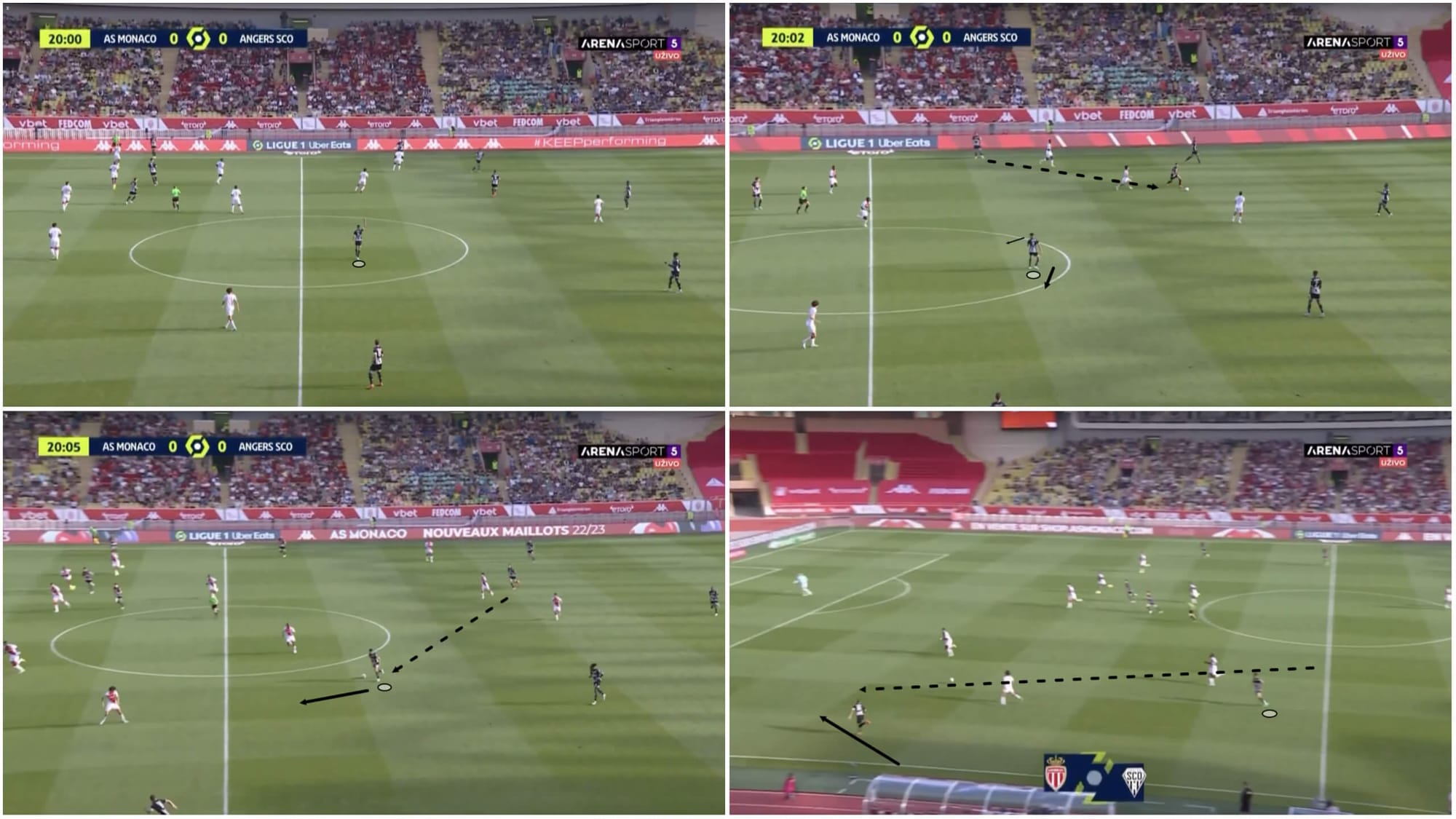
Ounahi is good at pulling away from opposition markers and finding space in key central areas when possible, as we see in figure 8. Here, he dropped deep, gave his teammates a great option centrally and ultimately received the ball as his side looked to play out of pressure on the right, escaping through the centre and towards the left against a deep opposition defensive block.
This space is all Ounahi needs to forge a decent opportunity for his side, as he’s turned around and begun driving forward with the ball as soon as it reaches his feet, well before the nearest opposition midfielder is anywhere near him to try and halt his progress.
While running onto the ball here in the bottom-left quadrant, the midfielder gets his head up, spots an overlapping run on the left wing and opts to split the opposition’s backline open with a through ball that plays this overlapping runner into the final third, which we can see in the bottom-right quadrant.
Ounahi quickly adds a spark to the attack that takes it from a picture of a team toiling away in possession against a solid low block to a picture of a team carving open that low block, finding a way into the final third and generating a good opportunity to create something.
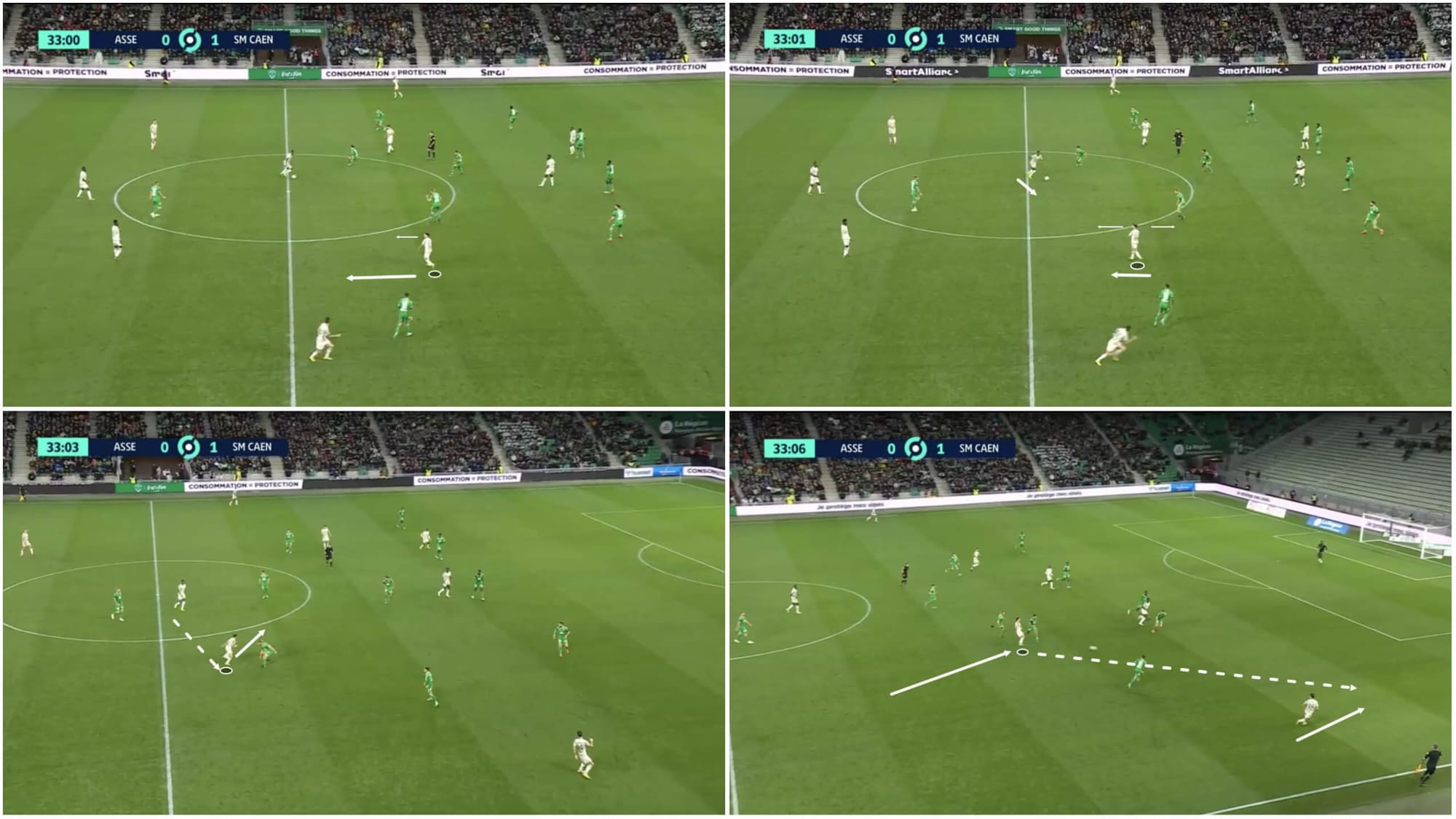
Brahimi performs similarly in figure 9, first dropping deep to generate a bit more space for himself to drive into on the ball and turn on receiving, which we can see worked out well as we progress into the bottom-left quadrant and see Brahimi in possession facing forward and getting ready to go around an opposition player who’s stepped out to confront him.
On receiving the pass, Brahimi initially turned to face a slightly wider position but quickly redirected himself more centrally, duping the defensive player and finding a pathway through the opposition’s midfield in the process.
After getting around this player, Brahimi attracts a few more defenders towards him as he drives deeper into the opposition’s half, eventually creating an opportunity to split the defence open with a through ball as we advance into the bottom-right quadrant. He sends a wide runner through into the final third, setting up a good opportunity for chance creation behind the opposition’s defence.
There’s some similarity in the pass selection of both players in these two situations as well as their ability to receive and quickly turn to face forward in their central midfield positions. Additionally, it’s notable how both players use their scanning effectively before receiving the ball in these two scenarios to ensure they’ve got the space they want to turn and drive forward after receiving the pass and to help them with their decision-making after receiving the ball in terms of their next action, their goal with this move and their next pass. We witness the positive results of this scanning for both players in the above examples.
Ball-carrying comparison
Ounahi’s ball-carrying is arguably the most impressive and most important area of his game. The Moroccan can be very natural and confident with the ball at his feet, which is an important skill for his teams to help him highlight and accentuate.
Both in settled possession phases and in transition to attack, a large part of Ounahi’s game is getting on the ball, facing forward and driving at the opposition’s defence. To create danger and uneasiness for the defenders.
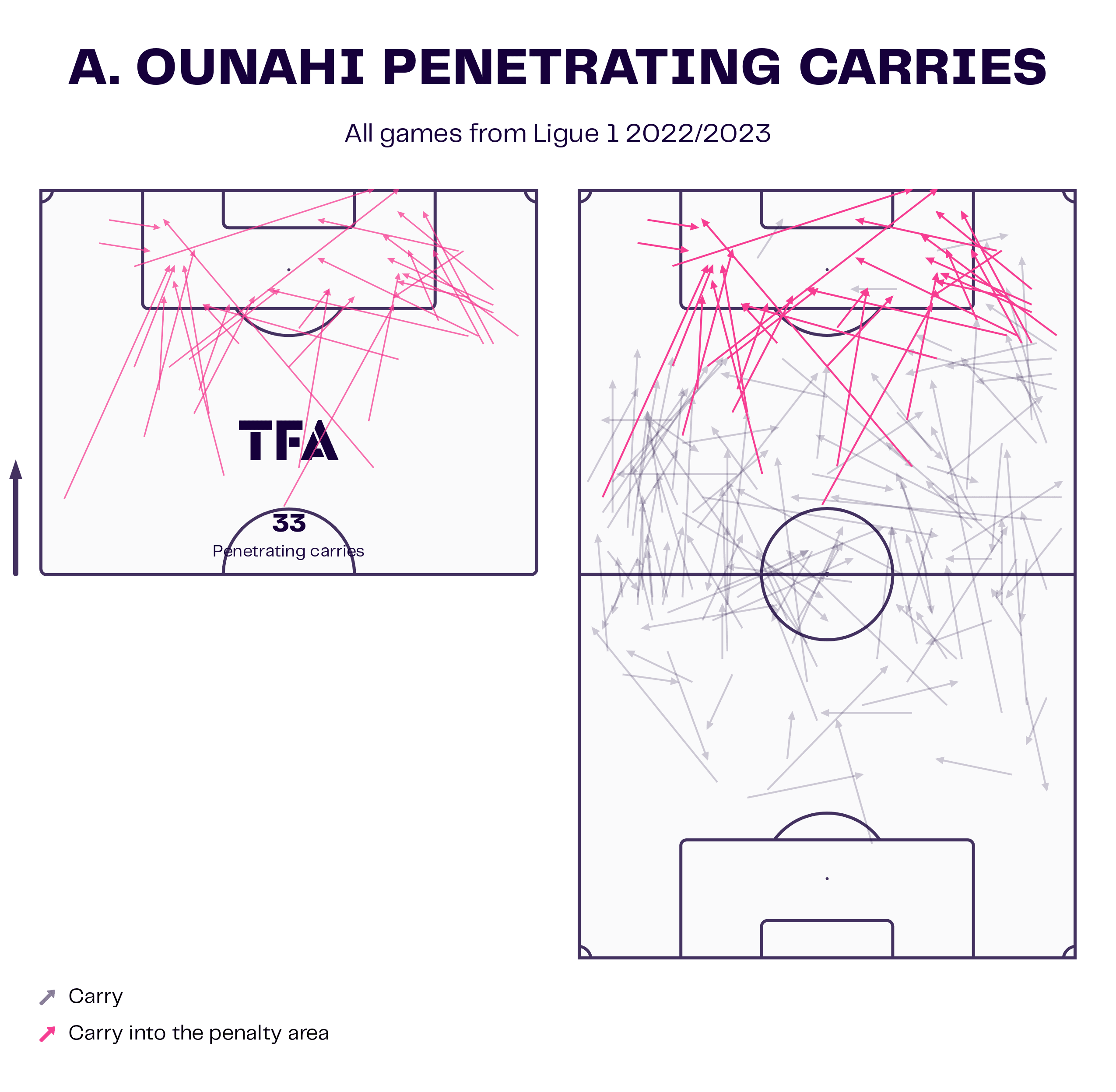
Figure 10 exhibits Ounahi’s penetrating carries from 2022/23, with carries into the penalty area highlighted in pink. This shows us how common it is for the 22-year-old to get on the ball and break lines, driving past players with the ball at his feet.
He’s comfortable carrying the ball from a deep starting position just inside his own half or from more advanced starting positions, with the majority of these carries starting either at about the halfway line or just on the edge of the final third — the latter being resemblant of Ounahi’s penetrative passes from the previous section.
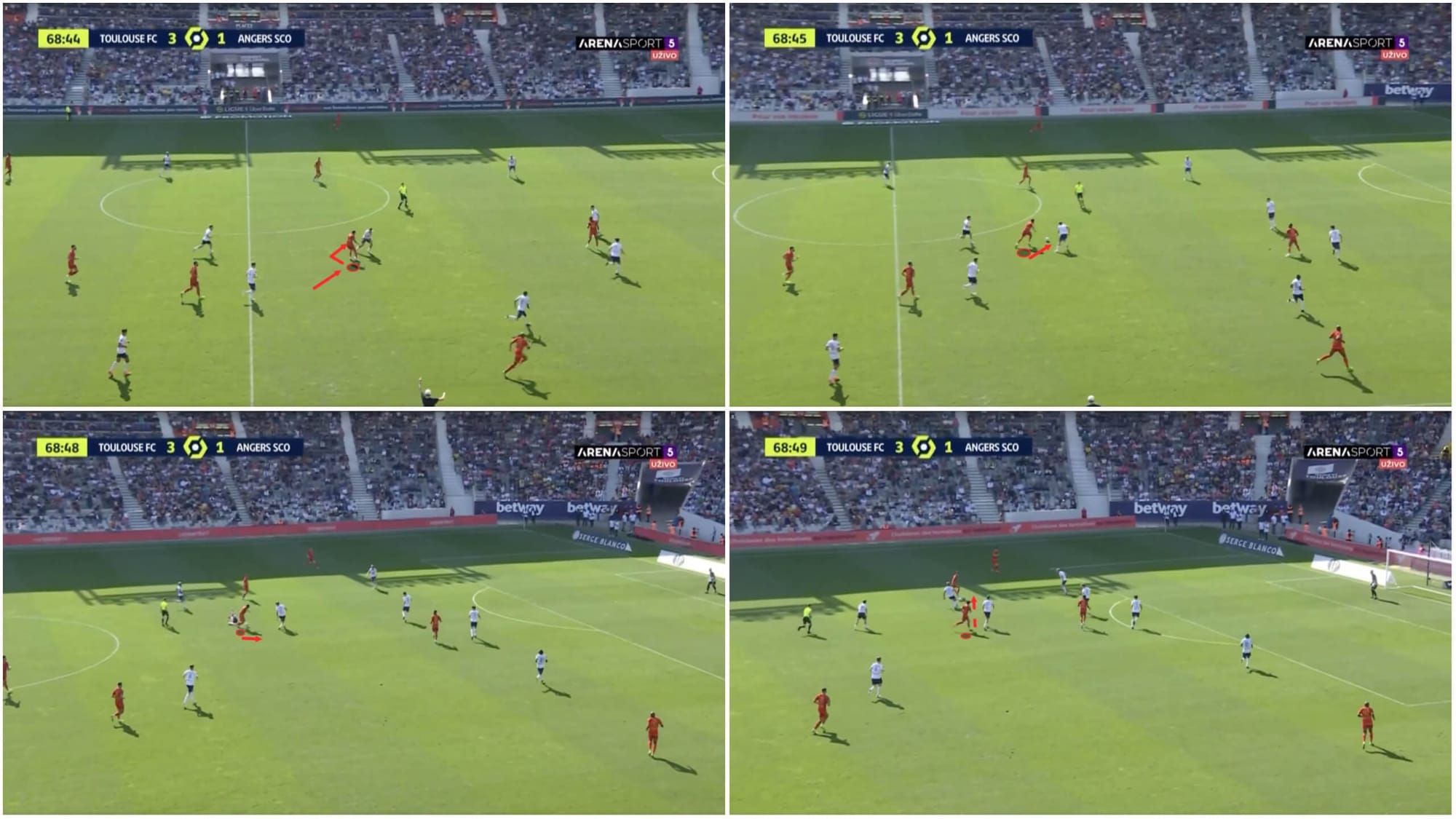
Ounahi’s got quick feet that can help him to dance past players 1v1 as we see in the top half of figure 11. Here, he drives at a player and swiftly shifts the ball between his feet from right to left while swivelling his hips, mesmerising the defender and progressing beyond him deeper into the opposition’s half.
The 22-year-old has excellent agility and flexible hips that help him to change direction sharply to bypass defenders as we saw in this example. However, Ounahi’s ball-carrying isn’t all just agility and technical quality, his physicality extends to his strength and ability to protect the ball with his body in the manner we see in the bottom-left quadrant above.
As the attack progressed, Ounahi was approached by an opposition defender who attempted to outmuscle the dribbler and shoulder him off the ball. However, Ounahi held his own and ended up flooring the defensive player, who perhaps underestimated this element of the Moroccan’s game.
From here, Ounahi decided he’d carried the ball as far as he could, having progressed from just beyond the halfway line into the final third, and delivered the ball out wide to his teammate inside the final third who could drive at the opposition’s full-back 1v1 from here and either create a crossing opportunity from wide or progress Angers into the penalty area.
This opportunity to enter the final third was all down to Ounahi’s technical and physical qualities on the ball and highlight why he made such a name for himself via his fearless ball-carrying at the World Cup. The midfielder has made 4.31 progressive runs per 90 in Ligue 1 this term, which is the second-most of any central midfielder/attacking midfielder in France’s top flight in 2022/23.
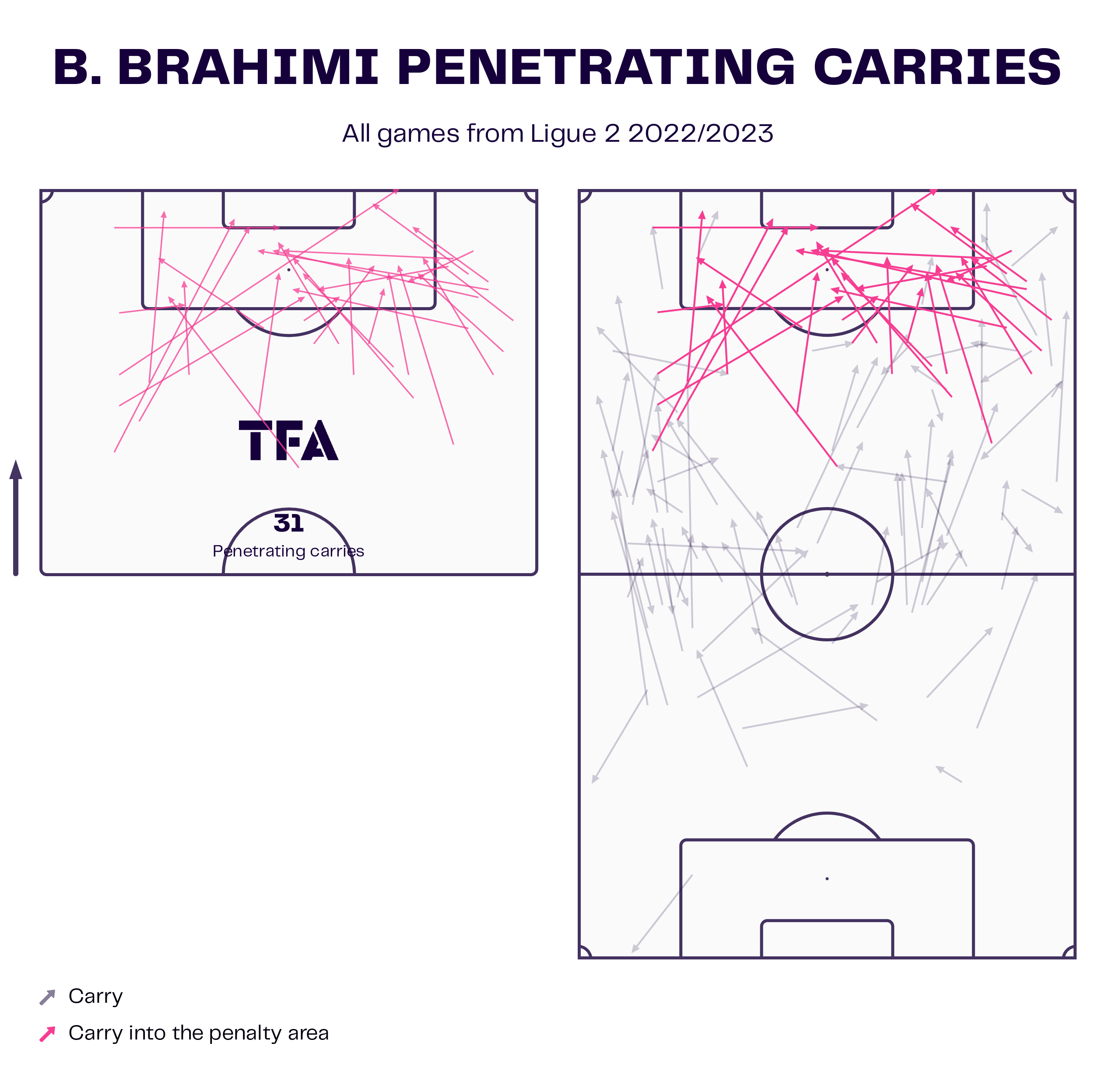
Brahimi is very much in this same mould of a fearless ball carrier happy to get on the ball, turn and drive at defenders from central positions. We can see his penetrating carries from 2022/23 in figure 12. It’s worth noting Brahimi’s made just two fewer carries in Ligue 2 this term than Ounahi has made in Ligue 1, despite the Caen man enjoying 341 fewer minutes of league football than the Angers midfielder has this season.
Many of Brahimi’s penetrative carries come from the half-spaces and plenty of them start just on the edge of the final third, which is all quite similar to Ounahi.
Brahimi has enjoyed lots of success as a dribbler this season with Caen, boasting an outstanding 74.29% dribble success rate from his relatively high 3.9 dribbles per 90. Additionally, his 3.79 progressive runs per 90 rank him second for that particular metric among central midfielders/attacking midfielders in Ligue 2.
He’s a fast, powerful dribbler who’s capable of carrying the ball forward quickly while keeping the ball under close control, tight to his body. He’s got a dangerous change of pace in his game which can make him extremely difficult to defend against with the ball at his feet when you look at distancing yourself as a defender and trying to control the tricky dribbler. We often see the 22-year-old getting his head up surveying options around him in between touches while carrying the ball forward, helping him to decide his next move.
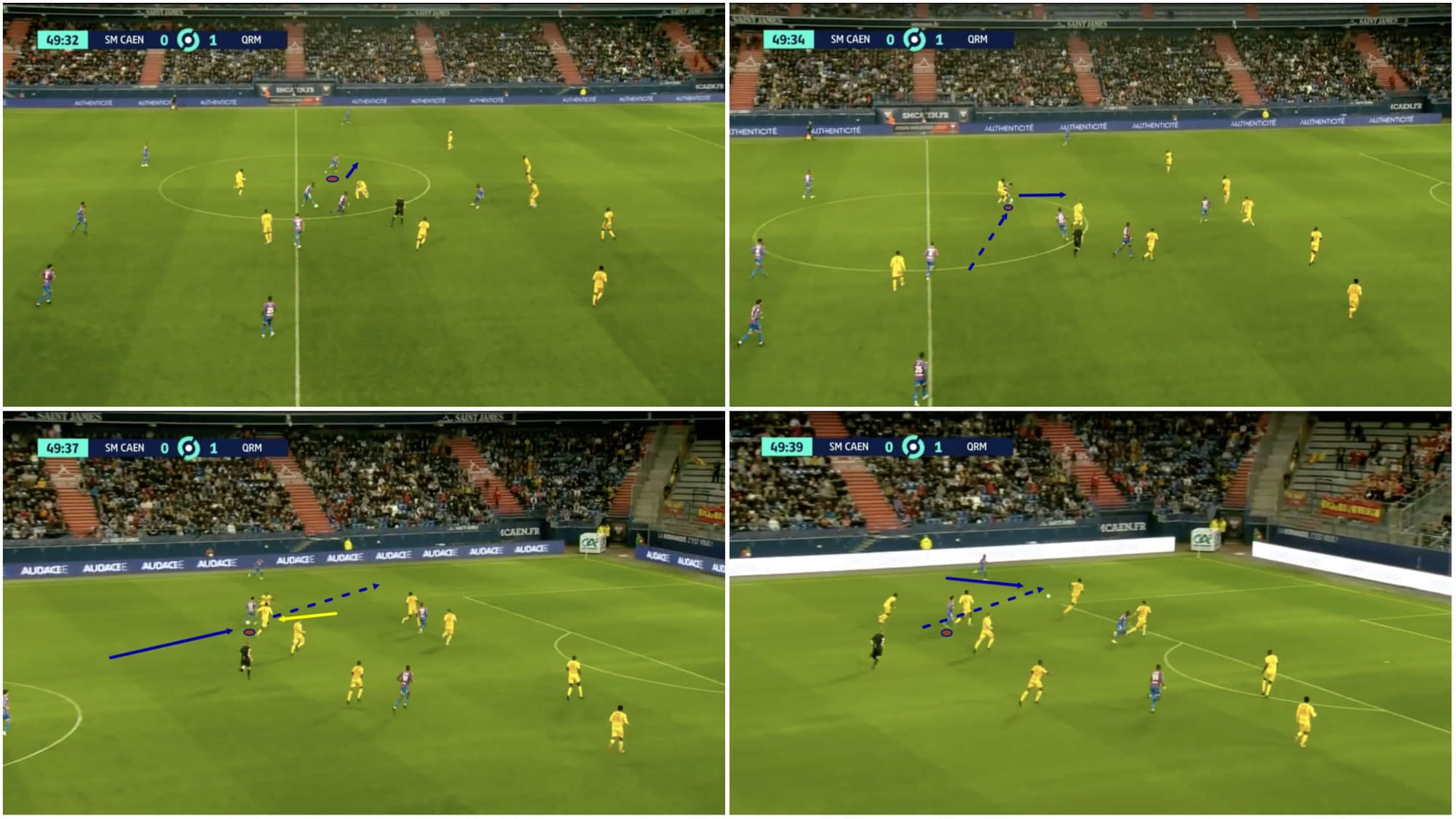
We saw one example of Brahimi’s ball-carrying in the previous section, and one particular technique he uses a lot in his 1v1 duels: his tendency to receive, turn and quickly change direction after baiting a defender to commit to a challenge, thus leaving him in his wake as he progresses beyond that defender and further upfield.
Figure 13 shows us more of Brahimi’s ball-carrying qualities — technical and physical. Firstly, we see the midfielder pulling away into space behind the opposition midfielders, again finding freedom in valuable central areas via his off-the-ball movement, a valuable quality and especially important for this role at Caen and Ounahi’s role at Angers.
This creates space for Caen to safely play the ball to Brahimi, who can turn and start driving forward with the ball as we move on into the top-right quadrant above. We can see he’s attracted pressure as he receives on the half-turn but the 22-year-old uses his balance, agile hips and physical strength to ride this challenge and hold off the defender while turning and picking up speed before eventually galloping away from this challenger as he aims to drive at defenders ahead of him and progress his team into a valuable position for chance creation in the final third, which is where this image takes us in the bottom-left quadrant.
Finally, as we advance into the bottom-right quadrant, we see that the Caen man has successfully set up his wide teammate to get on the ball in the final third in lots of space — a very favourable attacking scenario created via Brahimi’s technical and physical ball-carrying qualities after he received the ball just beyond the halfway line. This attack bears plenty of similarities to the Angers attack spearheaded by Ounahi in figure 12, providing just one example of these two players’ comparable qualities, tendencies and abilities on the ball.
Conclusion
In conclusion of this tactical analysis and scout report, indeed, Brahimi plays at a lower level than Ounahi and has enjoyed fewer minutes on top of that this season, but he’s demonstrated great quality for the level with the minutes he’s had as a progressive carrier, progressive passer and chance creator, especially from the left half-space, bearing similarities to Ounahi in all of that.
Brahimi is a great stylistic match for Ounahi and someone we’d recommend Angers to consider should they need to seek a replacement for their Moroccan World Cup star. In any event, we imagine you’ll see Brahimi progressing to a higher level before too long.

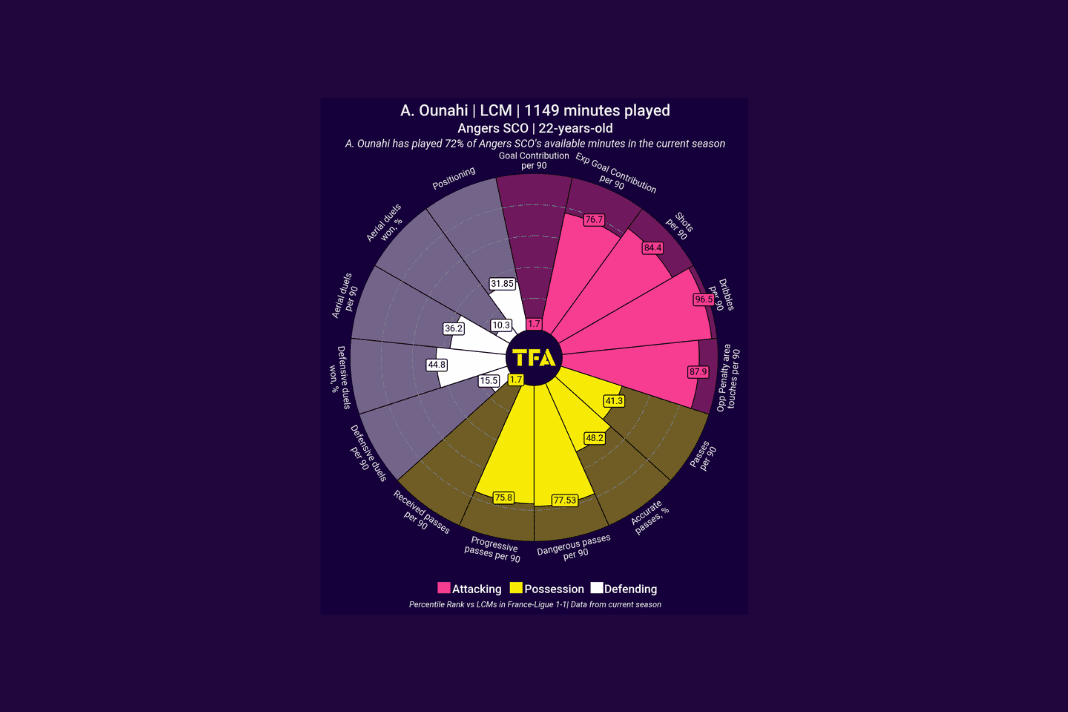



Comments